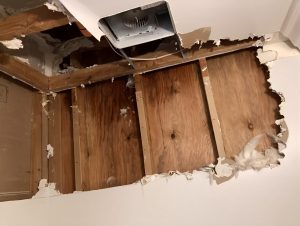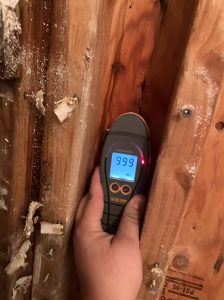Identifying Concealed Water Damage in Drywall: Signs and Detection Tips
Water damage in your home can lead to a myriad of issues, including structural damage, mold growth, and reduced indoor air quality. One of the most challenging aspects of water damage is detecting moisture hidden behind drywall. Knowing the signs of water damage behind your walls is crucial for timely intervention and minimizing the extent of the damage. In this article, we will discuss various methods to help you determine if there is water behind your drywall and the steps to take if you suspect hidden water damage.

Signs of Water Damage Behind Drywall
- Discoloration and Stains One of the most noticeable signs of water damage behind drywall is discoloration or staining on the wall’s surface. This may appear as yellow, brown, or dark spots, which can indicate moisture seeping through the drywall from behind.
- Peeling Paint or Wallpaper When moisture accumulates behind drywall, it can cause the paint or wallpaper on the wall’s surface to bubble, peel, or crack. If you notice these signs, it may be an indication of hidden water damage.
- Musty Odors A musty or moldy odor in a room can be a telltale sign of hidden moisture and potential mold growth behind the drywall. This smell typically indicates that water damage has been present for an extended period and requires immediate attention.
- Warped or Buckled Drywall Excessive moisture can cause drywall to warp or buckle, resulting in an uneven or distorted appearance. If you observe these changes in your drywall, it could be due to water damage behind the wall.
- Mold Growth Visible mold growth on the surface of the drywall or along baseboards may indicate water damage behind the wall. Mold requires moisture to thrive, so its presence often signifies an underlying moisture issue.
Methods for Detecting Water Behind Drywall
- Visual Inspection Conduct a thorough visual inspection of the wall, looking for the signs mentioned above. If you have access to the other side of the wall, such as through an attic or crawl space, inspect the backside of the drywall for signs of water damage as well.
- Moisture Meter A moisture meter is a device that measures the moisture content of materials, including drywall. By using a moisture meter, you can detect elevated moisture levels behind the wall, which can indicate hidden water damage. Some moisture meters require you to insert probes into the drywall, while others use non-invasive methods, such as radiofrequency technology, to detect moisture without damaging the wall.
- Infrared Camera An infrared camera, also known as a thermal imaging camera, can be used to detect temperature differences within the wall, which can indicate the presence of moisture. Cooler areas on the wall may signify hidden water damage, as water can cause temperature variations. While infrared cameras can be expensive, some professionals offer thermal imaging services to help detect hidden moisture.
What to Do If You Suspect Water Damage Behind Drywall
- Identify and Fix the Source The first step when dealing with suspected water damage behind drywall is to identify and fix the source of the moisture. This may involve repairing a leaking pipe, fixing a damaged roof, or addressing inadequate waterproofing.
- Consult a Professional If you suspect water damage behind your drywall, it is crucial to consult a professional. Water damage restoration specialists such as Water Damage Restore 247 can assess the extent of the damage, advise on the best course of action, and perform the necessary repairs or remediation.
- Remove and Replace Damaged Materials In some cases, it may be necessary to remove and replace the damaged drywall and any affected insulation or framing. This will help to prevent mold growth and restore the structural integrity of the wall.

